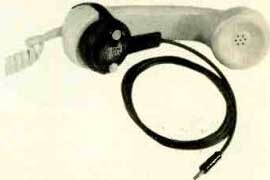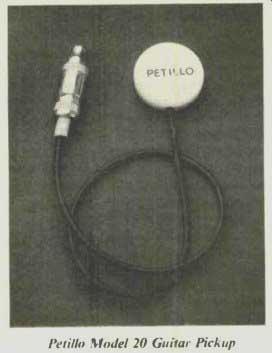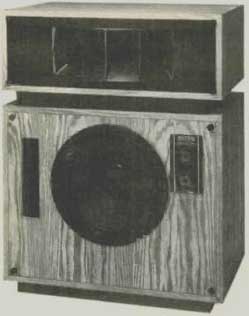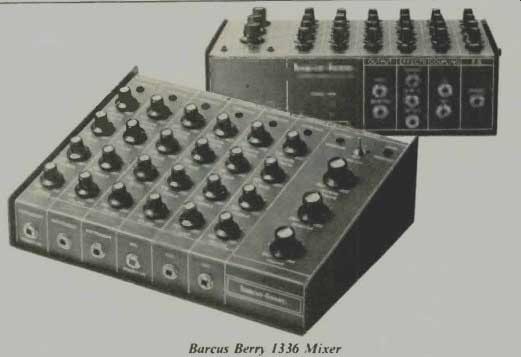
--- Fender Super Twin Reverb Amplifier.
The Fender Twin Reverb has long been a favorite of guitarists in the industry due to its durability and clean, accurate sound reproduction. In an effort to gild the lily, Fender has announced the re lease of its new Super Twin Reverb, which adds distortion controls, a five-band equalizer, a presence control, and many pounds to its predecessor. (The new baby weighs close to 100 pounds.
Fortunately, it comes with a set of casters.) Front panel controls include VOLUME, which when pulled out activates a BRIGHT switch, TREBLE. MIDDLE. BASS, DISTORTION. OUTPUT--for master vol Fender Super Thin Rererh ume control--and a five-band equalizer.
The usual two inputs and pilot light appear to the extreme left of the front panel next to the AC (power) and standby switches, both of which have been conveniently moved from the back of the amp. Located on the back panel is the LINE/RECORDING jack (which will feed a PA system. tape recorder, or direct box in a recording studio), HUM BALANCE, an accessory AC outlet (250 watts maximum), and a three-position ground switch.
The Equalization and Harmonic Balance section is composed of separate controls for 2.300 Hz. 1,250 Hz. 485 Hz, 235 Hz. and 100 Hz. It works extremely well and cleanly and can be switched in or out with a supplied footswitch. PRES ENCE comes in handy when you thought you had your sound just right but suddenly can't hear it over the rest of the band. The equalizer footswitch also houses an on/off distortion switch and a switch labeled DST for volume boost when DISTORTION is engaged. A second footswitch is supplied to control reverberation. Footswitch and AC cables are heavy-duty and should last a long time, as should their respective connectors to the amp. Even the RCA plugs feeding the reverb spring to the electronics are housed in heavy plastic.
We field-tested the Super Twin with guitarist with John Stowell, who subsequently decided to use it on his forthcoming LP for Inner City. The sound was clean and he was able to get what he wanted. The variety of sounds available-what with the five-band equalizer, the distortion controls. etc.-is an obvious plus, as is having 180 watts coming out of an amplifier of that size. As we were hauling it into the studio. Stowell remarked that the case left something to be desired.
Apparently the "pre-CBS" Fender amps used heavy plywood for the case panels that run lengthwise across the back of the amp. The Super Twin uses thin composition board instead. This may have kept it from weighing over 100 pounds. but it seems scant protection for the speakers and all those expensive vacuum tubes.
Overall, this is a very good instrument. Personally, I'm not convinced that it has the warmth of earlier Fender amps. but it's a versatile, powerful, and well-built tool. Retail price is $745.

Shure Model 50 AC Telephone Acoustic Coupler. Occasionally, a record
producer will call the studio to check out how the rough mixes sound.
Or the artist may call to see how the edit went. One way to appease their
curiosity is to hold the phone up to the speaker and shush everyone who
comes into the room.
What the producer hears is an uneven stereo balance, room ambience, and people tiptoeing around shushing each other. Add to that the band tuning up in the studio, the delivery boy's arrival with lunch, and the bass player's sudden coughing attack.
In a spectacular stroke of beneficence, Shure has provided a way to wipe out all those little annoyances with the 50 AC Acoustic Coupler: a small speaker, cased in molded rubber, with a chord that attaches to the output of your cassette recorder (or whatever you adapt it for).
The speaker fits perfectly over the telephone mouthpiece and can be strapped onto the handset so that you needn't hold it there. Frequency response is de signed to match that of the microphone in your telephone. The casing is sturdy, and the coupler weighs all of 4 ounces.
Now the producer won't panic when he hears a noisy playback. And, when you've been up all night dictating the Shure Telephone Acoustic Coupler Great American Novel into your cassette machine, you can play it back to your brother in Minneapolis while you go back to sleep. Whatever use you find for the 50 AC. it'll do the job well and costs only $28.50.

Petillo Model 20 Guitar Pickup. Petillo is a small family-run
company that until recently was known only for its hand made guitars.
Work with James Taylor on guitar pickups and with jazz giant Tal Farlow
on a new guitar has led to several new acoustic pickups, one of which
is the Model 20. It's about the size of a quarter, and is enclosed in
a mother-of-pearl shell. The lead wire terminates in a female mini-connector,
which can be adapted to a standard guitar cable. It uses no battery or
preamplifier and is mounted just behind the bridge with pressure-sensitive
tape (supplied). The sound is clean and even, and the reproduction good.
As with other pickups of this type, it is sensitive to other noises coming
from the guitar, such as string sliding and thumps.
The Model 20 is simple to use, and al though I've never been a fan of double-sided tape to hold a pickup on a guitar, its $45 price tag puts it in a different category from the more elaborate Polytone or D'Armond pickups, both of which at tach with a little more security. Its size precludes any danger of its getting in the player's way.
--Petillo Model 20 Guitar Pickup

Altec Model 19 Speaker System. At the studio when. I
spend all my days and some of my nights, we monitor commercial recordings
on Altec 604s. So when the 19s came out. I had to hear them. We brought
a pair to the studio to compare them A/B style with the 604s. After somehow
managing to get them up the stairs (they measure 21 inches deep by 30
inches wide by 39 inches high) we gave them a pink noise test, which involves
playing back random noise through the speaker and measuring the frequency
response with a calibrated microphone.
The curve showed a fairly flat response, which is to say there were no peaks or dips that might significantly color the Altec Model 19 sound. Overall, the sound was very pleasing although somewhat on the bright side.
Originally designed for high-end home audiophile use, the 19s will be marketed for professional recording as well. I found them a bit overwhelming as control-room monitors, but then I'm used to my Acousti-Voiced 604s. Rock, jazz, and classical sounded equally good, indicating that the 19s make an accurate all-round system.
The new element here is the 802 8G driver, which when combined with the standard 15-inch woofer (416 8B) and 811 B horn yields a very high quality speaker. The Dual Bank Eq. Crossover permits some tuning of the system to suit your particular listening conditions.
Connections from the amplifier are located under the cabinet. There has never been an ideal or standard studio monitor-there probably never will be. The Model 19 isn't one either, but it is quite a overload, a low-cut (100 Hz) filter, REVERB (return), MONITOR (send), and MASTER VOLUME output. Standard 1/4-inch phone jacks accommodate inputs on the front of the mixer; the back-panel jacks include MAIN and MONITOR output (each fed to separate amplifiers), and SEND HI, SEND LOW, RECEIVE for patching in external equalizers, tape delays, or whatever.
IN and our coupling jacks permit attaching to other 1336 mixers for more input capability, and a jack marked FS is provided for a footswitch (not supplied) to control reverb externally.
The bass and treble controls work fine and, in addition to being wide-range tone controls, can be very handy in con trolling feedback. The inclusion of a low-cut filter and LEDs for overload is a sensible move. All pots operate smoothly and are virtually free of noise, and provisions have bean made for most standard external connections. Perhaps the most bothersome feature is the fact that the nice sounding speaker. and I'd love to have a pair at home. Retail price is about $660 per unit.
----Barcus Berry 1336 Mixer

Barcus Berry Model 1336 Mixer. Barcus
Berry. long known for its musical instrument pickups and more recently
for its stage amplifiers, enters the PA mixer arena with Models 1334
and 1336. De signed to fill the needs of a low-cost PA setup, the 1336
is versatile and well put together. Each of the six inputs-three for magnetic
or acoustic-instrument pickups, three for high-impedance microphones-has
the following set of controls: BASS and TREBLE (offering 10 and 20
dB of boost or cut, respectively). REVERB/EFFECTS, and VOLUME. Separate
LEDs for each indicate overload.
The output section has two more LEDs for battery supply status and level master monitor control has no separate volume pots to feed it. It's nice to be able to feed your monitor system with a different overall level than is fed to the room, but that's all you can do--you're locked into the PA mix. You may want the audience to hear the lead guitar louder than anything else, but your primary concern in monitoring should be the rhythm section. The 1336 is a good, flexible mixer and unquestionably worth the money, but I'd have been willing to pay the extra for a little more freedom of choice. Frequency response of the 1336 is said to be within 3 dB from 100 Hz to 25 kHz, signal-to-noise ratio is 83 dB, and the mixer uses four 9-volt cells. It weighs only 5 pounds-a definite advantage-and measures about 4 by 12 by 9 inches. Suggested list price is under $160.
-FRED MILLER
---------
(High Fidelity, Nov. 1977)
Also see:
What's Out In Semipro Consoles